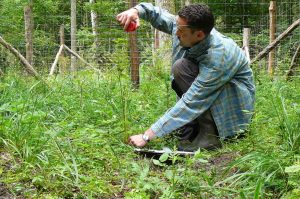| Czas trwania projektu: | 2013-2015 |
|---|---|
| Status projektu: | Zakończony |
| Kierownik projektu: | Dr hab. Dries Kuijper |
| Wykonawcy projektu: |
Marcin Churski Kuba Bubnicki |
Efekt kaskady troficznej w europejskich lasach strefy umiarkowanej: pośredni wpływ dużych drapieżników na interakcje ssaki kopytne – odnowienie lasu.
Trophic cascades in European temperate forests; indirect effects of large carnivores on ungulate-tree interactions.
Background to the research:
Our understanding of the role that large carnivores play in influencing plant-herbivore interactions and how this is structuring ecosystems is only beginning to develop. Their effects can be both directly (by reducing population level) and indirectly (by creating a landscape of fear). Recent studies illustrated that these indirect non-lethal effects of carnivores may be as important or even of greater importance in influencing herbivore-plant interactions. The presence of carnivores can influence behaviour, habitat choice and eventually spatial distribution of ungulate species that are preyed upon. Much of our knowledge originates from American study systems, such as the Yellowstone National Park. Very little is known how these processes work in European systems which often largely differ in scale and landscape heterogeneity from American ecosystems. Our studies focus on the indirect influences of wolf and lynx on the foraging behaviour and spatial distribution of ungulates (especially red deer) inside the dense forest of Białowieża.
Goals:
We want to answer among other the following questions:
- does the scent of a predator (wolf, lynx) influence foraging decisions of their main prey species (red deer, roe deer)
- do fine-scale habitat elements (such as fallen trees) act as escape impediments and affect behavior and spatial distribution of ungulates?
- do ungulates avoid core areas of territoria of their main predators?
- do these changes in behavior of ungulates lead to measurable affects on tree recuitment or tree species composition?
Methods:
- camera traps to study behavior and spatial distribution of ungulates in natural conditions and in small-scale experiments
- measurements on tree saplings to study browsing impact and growth
Relevant reading material
- Kuijper, D.P.J., Verwijmeren M., Churski, M., Zbyryt, A, Schmidt, K., Jędrzejewska, B., Smit, C. 2014. What cues do ungulates use to assess predation risk in dense temperate forests? PLoS ONE 9(1): e84607. doi:10.1371/journal.pone.0084607
- Kuijper, D.P.J., de Kleine, C., Churski, M., van Hooft, P., Bubnicki, J., Jędrzejewska, B. 2013. Landscape of fear in Europe: wolves affect spatial patterns of ungulate browsing in Białowieża Primeval Forest, Poland. Ecography 36: 1263-1275, doi: 10.1111/j.1600-0587.2013.00266.x
- van Ginkel, H.A.L., Kuijper, D.P.J., Churski, M., Zub, K., Szafrańska, P., Smit, C.. 2013. Safe for saplings not safe for seeds: Quercus robur recruitment in relation to coarse woody debris in Białowieża Primeval forest, Poland. Forest Ecology and Management 304: 73-79.
- Smit, C., Kuijper, D.P.J., Prentice, D., Wassen, M., Cromsigt, J.P.G.M. 2012. Coarse woody debris facilitates oak recruitment in Białowieża Primeval Forest, Poland. Forest Ecology and Management 284 (2012): 133-141. http://dx.doi.org/10.1016/j.foreco.2012.07.052
- Kuijper, D.P.J., Jędrzejewska, B., Brzeziecki, B., Churski, M., Jędrzejewski, W., Żybura, H. 2010. Fluctuating ungulate density shapes tree recruitment in natural stands of the Białowieża Primeval forest, Poland. Journal of Vegetation Science 21: 1082-1098. DOI: 10.1111/j.1654-1103.2010.01217.x
- Kuijper, D.P.J., Cromsigt, , J.P.G.M., Jędrzejewska, B., Miścicki, S., Churski, M., Jędrzejewski, W., Kweczlich, I. 2010. Bottom-up versus top-down control of tree regeneration in the Białowieża Primeval Forest, Poland. Journal of Ecology 98: 888-899. doi: 10.1111/j.1365-2745.2010.01656.x
Volunteers
The projects offers opportunities for master students or internship students to answer (part of) the questions mentioned in the goals of the project. Please contact Dries Kuijper for more information.



